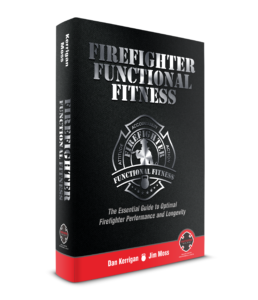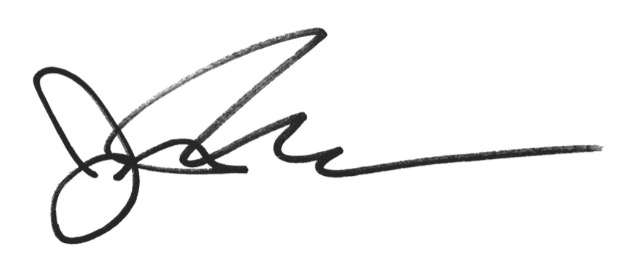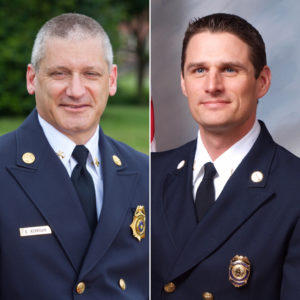Firefighter Functional Fitness
By Dan Kerrigan & Jim Moss
(Excerpt from Chapter 1 of the Firefighter Functional Fitness Book)
CHAPTER 1 – A Size-Up
“Being fit for duty is the most basic requirement for every firefighter—both career and volunteer.”
—Dan Kerrigan and Jim Moss*Â
FITNESS AS A FIRE SERVICE REQUIREMENT
If there is one overarching theme to take away from this book, it is this: Being physically fit for duty is one of the most vital and fundamental ingredients of being a successful firefighter.
We are so passionate about this topic and believe in it so much that we are on a mission to assist all firefighters to become functionally fit and healthy so they can optimally perform on the fireground and in life.
For those of us who have gone through a fire academy or have participated in a new-hire testing process, one of the very first things that we did was complete a physical agility test. Before any skills training or classroom training, every aspiring firefighter typically has to pass a physical agility test to ensure that they have the potential to become a certified firefighter.
As David J. Soler has shared in Firefighter Preplan, in the heat of battle, fire does not distinguish between career, paid on-call, volunteer, male, female, young or old firefighters. Fire is a punishing and unforgiving adversary to all firefighters, regardless of their monetary compensation, gender, or age. Firefighting is physically and mentally demanding, requiring all firefighters to approach their fitness with the same level of commitment that they have for their fireground skills and knowledge.
As the old fire service adage goes, you can never train too much for a job that can kill you. We believe this truth is equally applicable to fitness training as it is to firefighter skills training and didactic knowledge.
Firefighting is strenuous, and if we want to do it safely and effectively, it demands an elite level of physical performance. It is a job that requires muscular strength and endurance, optimal cardiovascular capacity, flexibility, core strength, resiliency, and more. The firegroundâ™s physical requirements impact our bodies beyond physical strength in ways that we often do not considerâ”most notably when we exceed our cardiovascular limits. Additionally, we must also consider that we perform these tasks while being exposed to arduous thermal and environmental conditions.
Consider all of the different roles and actions firefighters perform on the fireground:
- Pulling and advancing hose lines
- Flowing water from hose lines
- Opening fire hydrants
- Wearing heavy and cumbersome personal protective equipment
- Forcible entry or egress
- Ventilating roofs, windows, doors, etc.
- Securing utilities
- Raising and climbing ladders
- Search operations
- Civilian rescue
- Firefighter rescue
- Roof operations
- Breaching walls
- Dragging, lifting, hoisting, and carrying heavy equipment
- Overhaul
- Crawling, pushing, and pulling
THE EFFECTS OF AGING ON PHYSICAL PERFORMANCE
Over the course of 20 to 30 years, a firefighterâ™s time in the fire service can be unpredictable and grueling. Whether we are career, paid-on-call or volunteer, all of us want to maximize the longevity of our careers and retire âœhappy and healthy.â Unfortunately, we constantly hear stories of retired firefighters who either die only a couple years after they retire or they are basically disabled during their retirement.
Due to the natural process of aging, our bodies undergo several physiological changes. Unfortunately, all of these changes work against our physical fitness as we get older:
- Muscle mass and strength decreases (3 to 5 percent per decade)
- Cardiovascular capacity decreases (10 to 12 percent per decade, starting at age 30)
- Flexibility decreases (increasing the risk and severity of injuries)
- Rate of metabolism decreases (accelerating weight gain)
Taking all of these factors into account, we cannot overemphasize the importance of every firefighter adopting a regular functional fitness regimen at the beginning of their careers. Doing so will have an enormous impact on an entire career and retirement. Even if you are a veteran firefighter who has neglected your fitness, donâ™t worryâ”there is no time like the present to start. At any stage of your career, making small, positive changes in your fitness and nutrition habits will always reap benefits.
Firefighter Functional Fitness will make you more fit for the job, help keep your weight under control, reduce your risk of heart disease, diabetes, cancer, high blood pressure and high cholesterol, reduce stress, help you feel better, and add years to your life (while adding life to your years). By adopting Firefighter Functional Fitnessâ™ philosophy of balance and moderation now, you will reap big dividends for the rest of your career and retirement.
WHO SHOULD USE FIREFIGHTER FUNCTIONAL FITNESS?
When it comes to fitness, firefighters will typically fall into one of five categories:
- They lack the motivation to make fitness a priority.
- They want to make their fitness a priority, but they lack the knowledge and instruction to start and maintain a program.
- They have suffered an injury that physically hinders them from improving their fitness and maintaining a regimen.
- They regularly exercise, but their workout program is not specifically tailored to the job of firefighting.
- They are functionally fit firefighters who use Firefighter Functional Fitness to optimize their fireground performance.
Wherever you fall on this spectrum, Firefighter Functional Fitness will help you either get out of the recliner and get started, stay with a program, or maximize your fitness by making it functional for the job.
GOALS OF FIREFIGHTER FUNCTIONAL FITNESS:
- Maximize firefighter performance through the improvement of cardiovascular capacity, functional strength training, flexibility, recovery, hydration, nutrition, and a lifestyle of moderation.
- Improve a firefighterâ™s quality and longevity of their life, career, and retirement through functional fitness.
- Reduce the amount of firefighter line-of-duty deaths, job- related injuries, and health-related retirements.
- Reduce a firefighterâ™s risk of developing cardiovascular disease, obesity, diabetes, hypertension, high cholesterol, cancer, and other related health ailments.
- Increase functional strength, capacity, endurance, and resiliency as they specifically relate to a firefighterâ™s duties.
- Enhance physical performance and function.
- Achieve the best physical version of you.
Firefighter Functional Fitness is not a âœtraditionalâ workout program. Functionally fit firefighters are not concerned with having six-pack abs, a beach body physique, or aiming to hit a âœperfect numberâ on the scale. Similarly, they avoid performing unsafe exercises and movements, lifting excessive amounts of weight, and trying to be stronger or faster than anyone else.
Like fire itself, Firefighter Functional Fitness does not discriminate. It is a program for every firefighter, whether career or volunteer. It works for all ages, genders, ranks, races, and backgrounds. We are glad you chose to take your health and fitness seriously, and we welcome you on this journey to optimizing your performance and longevity.
WHAT WILL HAPPEN IF I DON’T TAKE MY FITNESS SERIOUSLY?
Unfortunately, there are too many firefighters who take their physical fitness for granted. Conservative estimates state 70 percent of the American fire service is overweight. Obesity, diabetes, and cancer are all on the rise within our profession. If you have been in the fire service for any amount of time, you already know that more than 50 percent of yearly line-of-duty deaths (LODDs) are caused by cardiovascular eventsâ”primarily heart attacks. These statistics are just the tip of the iceberg for the health epidemic that the American fire service is currently facing. The more we continue to choose âœrecliner timeâ over âœfitness time,â the faster and deeper we will dig our own graves.
Some may think firefighter fitness is a personal choice and its effects only have personal implications. The hard truth is our individual fitness levels affect our performance and our health. Our performance (or lack thereof) directly impacts fellow firefighters, the citizens we serve, and everyoneâ™s fireground safety. Our quality of health impacts our quality of life at home, it impacts our family, and it impacts the quality and longevity of our retirement.
So, if youâ™re on the fence about making your fitness a priority, remember that it directly affects numerous important people besides just you.
âœEven though firefighters only spend 1 percent of their time engaged in active firefighting duties, 32 percent of all firefighter line-of-duty deaths resulted during or shortly after this time.â
â”Dr. Stefanos Kales
*To learn more on the health-related LODD epidemic, cardiovascular disease in the fire service and the cardiovascular strain of firefighting, please read Chapter 19 â” What Is Killing Firefighters: The Cardiovascular Epidemic.
AFTER READING THIS BOOK, WHAT DO I NEED TO DO TO BE SUCCESSFUL WITH MY FUNCTIONAL FITNESS?
By reading this book, you have already taken a big step toward firefighter fitness success. You will now have all the facts needed to help you commit to firefighter functional fitness and make it an absolute requirement on a personal level.
Your personal attitude, accountability, and commitment to act are the three cornerstones for your success. We have written this book to provide you with the tools and concepts needed to take your fitness to the next level. We want you to accomplish this by applying what you read to your personal fitness program.
So, whatâ™s next?
Use this book to learn the fundamentals and also use it as a reference. Use it as motivation. Use it to teach your fellow firefighters why firefighter health and fitness are so important, and use it to become a champion for firefighter health and fitness.
Simply put: If you believe that being fit for duty and optimal physical performance are required of all firefighters and if you want to be a successful and effective firefighter, then Firefighter Functional Fitness is for you.
If you like what you read, we encourage you to check out FirefighterFunctionalFitness.com. Here you will find all the resources you need to continue on your path to optimal fireground performance through webinars, videos, training bulletins, demonstrations, explanations, and even live interaction with us. We look forward to working with you towards becoming a functionally fit firefighter!
THE AUTHORS’ STORIES:
OUR PERSONAL COMMITMENT TO FIREFIGHTER FUNCTIONAL FITNESS AND TO YOU
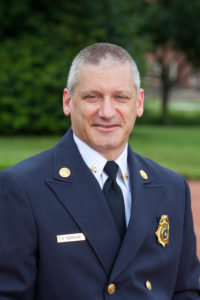
Dan Kerrigan
Dan Kerrigan:
Iâ™ll be honest. While I have always believed that fitness is essential to my effectiveness on the fireground and to my health in general, as a young man I had the same mentality that I see many younger firefighters display. When we are young, we believe we are invincible. Our focus is on becoming the best firefighter we can be, and this usually relates directly to our skills and knowledge.
I never had a problem âœkeeping upâ on the fireground when I was young. It was not until I got a little older that I started to realize a very sobering fact: My 40-year-old body could not compete with my 20-year-old brain. In this book, you will learn about the effects of aging that I began to experience firsthand. Several years ago, there was an arson crisis in my area. We were seeing a lot of work. A lot. It was tragic from a community standpoint, but it was also a personal eye-opener for me. I noticed that I was not able to recover as quickly as I used to, both on the fireground and in between fires. I was tired. I was sore. I found myself more reliant on that adrenaline boost than ever before.
Fortunately for me, I discovered Russian kettlebells. I immediately realized how âœfunctionalâ the movements were and how effective the training was. I am not here to âœsellâ kettlebells, but I am here to tell you that this was my âœah-haâ moment. I have since conducted applied research and have piloted functional fitness studies. I have implemented a functional fitness program at my department. I use The Big 8 of Firefighter Functional Fitness every day as the backbone of my fitness training. I have also learned to be more sensible about what I eat and focus on proper hydration and rest.
As a firefighter, I have always been very aggressive. I have always enjoyed the physical aspects of the work. As a chief officer, I have also come to recognize how much my own physical fitness has a direct bearing on how I handle stress and my ability to think and act decisively under pressure. Now, at nearly 50 years old, I can say without fear of contradiction that I am in the best functional shape of my career and my life. The proof is in performance. I see and feel it personally, and I can also see it in the firefighters in my department. They take functional fitness seriously, and they routinely outwork and outperform anyone on the fireground who does not take the same approach.
Firefighter Functional Fitness works. It is a comprehensive approach that you can use to improve and maintain your fitness for duty. By adopting the principles found in this book, you will be demonstrating to your fellow firefighters, community, and, most importantly, your family that you are serious about taking care of yourself.
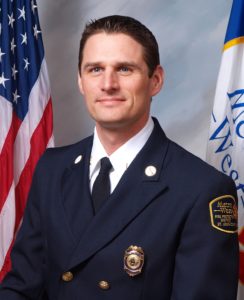
Jim Moss
Jim Moss:
Fitness has always been an important part of my lifeâ”even since childhood. I started to get serious about my fitness while I was in college; however, I narrowly focused my fitness on just improving my physique. Like almost everyone else, I was originally taught a strength and conditioning model that emphasized strength training based on body parts and muscles groups (i.e. bench press for âœchest,â leg extensions for âœquads,â etc.). Unfortunately, that fitness regimen did not fully prepare me for real-life function and performance.
On the path towards preparing for the fire academy, I started to gear my fitness specifically for firefighter performance. I would wear a backpack with 50 pounds of weight and do high-intensity interval training on a stair climber. I also used the cable resistance machines to simulate pulling a hose line and hoisting tools. I used pushing, pulling, carrying, lifting, and dragging exercises to maximize my functionality as a firefighter.
During a year-long period on the job, I unfortunately decided to strictly focus on strength training in an effort to âœbulk up.â Regrettably, I was neglecting my cardiovascular capacity, flexibility, core strength, and not incorporating enough rest into my weekly workouts. What resulted was a strained chest muscle and an injured shoulder. After those healed, I made it a goal to make my fitness specifically functional for the job of firefighting. I incorporated all aspects of The Big 8, while balancing rest, recovery, better hydration and improved nutrition.
At age 35, I can honestly say I am in the best shape of my life. With concepts found in Firefighter Functional Fitness, I have found balance and moderation in my fitness and health. I will admit I am not the biggest or strongest firefighter; however, I have recorded the fastest time on my fire departmentâ™s physical agility assessment for the past couple of years. As it pertains to the fireground, I have optimized my performance and I seldom need to rest. After a fire, I notice that my body and energy recover quickly and I am immediately ready for the next fire.
TRAIN LIKE YOU FIGHT; FIGHT LIKE YOU TRAIN
We firmly believe the greater we can make our fitness training mimic the intensity and realism of fireground activities, and the more emphasis we place on lifestyle choices that reflect a moderate, sensible, healthy approach, the less margin for failure we expose ourselves to when performing on the fireground.
We must not simply survive the fireground, we must be able to thrive on the fireground. It all starts with a foundation of functional fitness.
—
Thank you for reading Chapter 1 of Firefighter Functional Fitness: The Essential Guide to Optimal Firefighter Performance and Longevity.  We highly recommend that you invest in yourself and your career by purchasing a copy.  Its 320 pages are jam-packed with practical fitness, health, and nutrition principles that are easy-to-understand and implement.
In Fitness,
Dan Kerrigan & Jim Moss
Authors of Firefighter Functional Fitness
—

